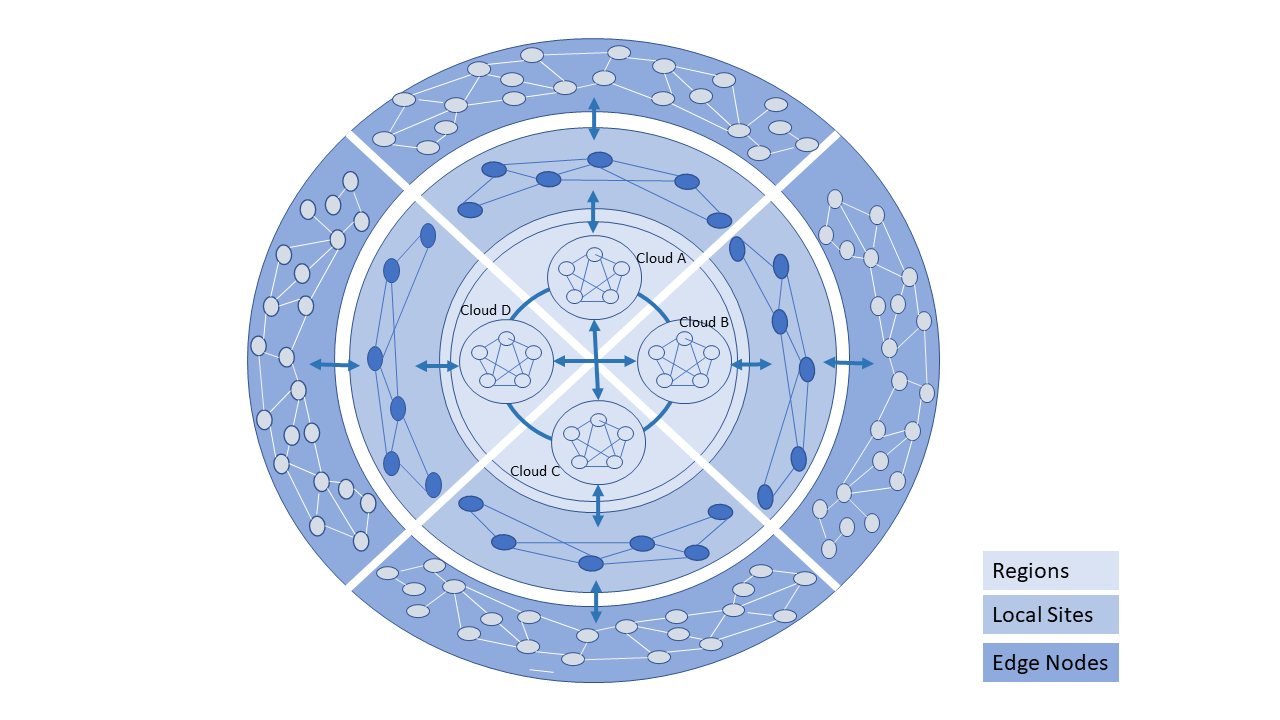
Cloud Infrastructure (CI) deployment environment for different edge deployments:
Controlled: Indoors, Protected, and Restricted environments. Data Centers, Central Offices, Indoor venues. Operational benefits for installation and maintenance, and reduced need for hardening/ruggedized.
Exposed: Outdoors, Exposed, Harsh and Unprotected environments. Expensive rugged equipment
Cloud Infrastructure (CI) hardware type for different edge deployments:
Commodity/Standard: COTS, standard hardware designs and form factors. Deployed only in Controlled environments. Reduced operational complexity.
Custom/Specialised: non-standard hardware designs including specialised components, ruggetised for harsh environments and different form factors. Deployed in Controlled and/or Exposed environments. Operationally complex environment.
Cloud Infrastructure (CI) hardware specifications for different edge deployments:
CNTT Basic: General Purpose CPU; Standard Design.
CNTT Network Intensive: CNTT Basic + high speed user plane (low latency, high throughput); Standard Design.
CNTT Network Intensive+ : CNTT Network Intensive + optional hardware acceleration (compared with software acceleration can result in lower power use and smaller physical size); possible Custom Design.
CNTT Network Intensive++ : CNTT Network Intensive + required hardware acceleration; Custom Design.
Server capabilities for different edge deployments and the OpenStack services that run on these servers; the OpenStack services are containerised to save resources, intrinsic availability and autoscaling:
Control nodes host the OpenStack control plane components (subset of Cloud Controller Services), and needs certain capabilities:
OpenStack services: Identity (keystone), Image (glance), Placement, Compute (nova), Networking (neutron) with ML2 plug-in
Message Queue, Database server
Network Interfaces: management, provider and overlay
Compute nodes host a subset of the Compute Node Services:
Hypervisor
OpenStack Compute nova-compute (creating/deleting instances)
OpenStack Networking neutron-l2-agent, VXLAN, metadata agent, and any dependencies
Network Interfaces: management, provider and overlay
Local Ephemeral Storage
Storage Nodes host the cinder-volume service. Storage nodes are optional and required only for some specific Edge deployments that need large persistent storage:
Block storage cinder-volume
Storage devices specific cinder volume drivers
Cloud partitioning: Host Aggregates, Availability Zones
OpenStack Edge Reference Architecture provides more depth and details
Edge Deployments:
Small footprint edge device: only networking agents
Single server: deploy multiple (one or more) Compute nodes
Single server: single Controller and multiple (one or more) Compute nodes
HA at edge (at least 2 edge servers): Multiple Controller and multiple Compute nodes
Higher level services such as Network Functions (includes composition of Network Functions to form higher level services) offered on Telco and other clouds (HCP, specialised, etc.). While here the discussion is about NFaaS, this is equally applicable to anything as a service (XaaS)

(PG: In the above diagram, replace "Local" with "Metro")
| Type | System Developer | System Maintenance | System Operated & Managed by | Location where Deployed | Primary Resource Consumption Models |
|---|---|---|---|---|---|
| Private (Internal Users) | Open Source | Self/Vendor | Self/Vendor | On Prem | Reserved, Dedicated |
| Private | Vendor | HCP | Self/Vendor | Self/Vendor | On Prem | Reserved, Dedicated |
| Public | Vendor | HCP | Self/Vendor | Self/Vendor | On Prem | Reserved, On Demand |
| Private | HCP | Vendor | Vendor | Vendor Locations | Reserved, Dedicated |
| Public (All Users) | HCP | Vendor | Vendor | Vendor Locations | On Demand, Reserved |
(RM Ch03 the new Edge Section)
| Characteristics | Other Terms | ||||||||||||||
|---|---|---|---|---|---|---|---|---|---|---|---|---|---|---|---|
| CNTT Term? | Compute | Storage | Networking | RTT* | Security | Scalability | Elasticity | Resiliency | Preferred Workload Architecture | Upgrades | OpenStack | OPNFV Edge | Edge Glossary | GSMA | |
Regional Data Center (DC) Fixed | 1000's Standardised >1 CPU >20 cores/CPU | 10's EB Standardised HDD and NVMe Permanence | >100 Gbps Standardised | ~100 ms | Highly Secure | Horizontal and unlimited scaling | Rapid spin up and down | Infrastructure architected for resiliency Redundancy for FT and HA | Microservices based Stateless Hosted on Containers | HW Refresh: ? Firmware: When required Platform SW: CD | Central Data Center | ||||
Metro Data Centers Fixed | 10's to 100's Standardised >1 CPU >20 cores/CPU | 100's PB Standardised NVMe on PCIe Permanence | > 100 Gbps Standardised | ~10 ms | Highly Secure | Horizontal but limited scaling | Rapid spin up and down | Infrastructure architected for some level of resiliency Redundancy for limited FT and HA | Microservices based Stateless Hosted on Containers | HW Refresh: ? Firmware: When required Platform SW: CD | Edge Site | Large Edge | Aggregation Edge | ||
Edge Fixed / Mobile | 10's Some Variability >=1 CPU >10 cores/CPU | 100 TB Standardised NVMe on PCIe Permanence / Ephemeral | 50 Gbps Standardised | ~5 ms | Low Level of Trust | Horizontal but highly constrained scaling, if any | Rapid spin up (when possible) and down | Applications designed for resiliency against infra failures No or highly limited redundancy | Microservices based Stateless Hosted on Containers | HW Refresh: ? Firmware: When required Platform SW: CD | Far Edge Site | Medium Edge | Access Edge / Aggregation Edge | ||
Mini-/Micro-Edge Mobile / Fixed | 1's High Variability Harsh Environments 1 CPU >2 cores/CPU | 10's GB NVMe Ephemeral Caching | 10 Gbps Connectivity not Guaranteed | <2 ms Located in network proximity of EUD/IoT | Untrusted | Limited Vertical Scaling (resizing) | Constrained | Applications designed for resiliency against infra failures No or highly limited redundancy | Microservices based or monolithic Stateless or Stateful Hosted on Containers or VMs Subject to QoS, adaptive to resource availability, viz. reduce resource consumption as they saturate | HW Refresh: ? Firmware: ? Platform SW: ? | Fog Computing (Mostly deprecated terminology) Extreme Edge Far Edge | Small Edge | Access Edge | ||
*RTT: Round Trip Times
EUD: End User Devices
IoT: Internet of Things